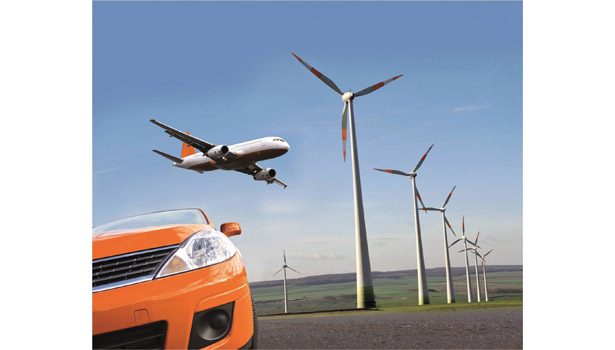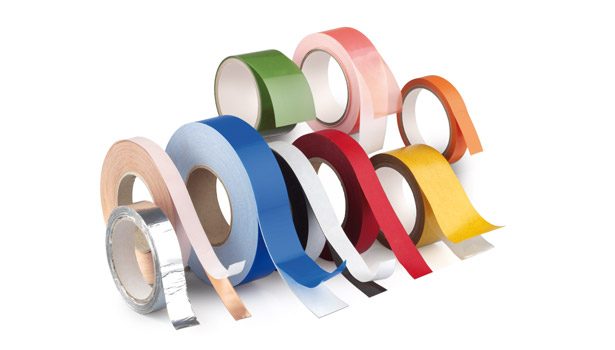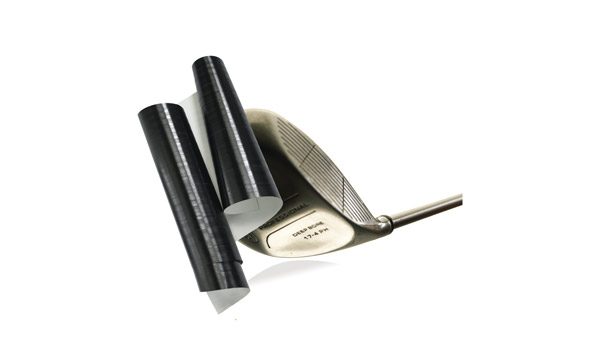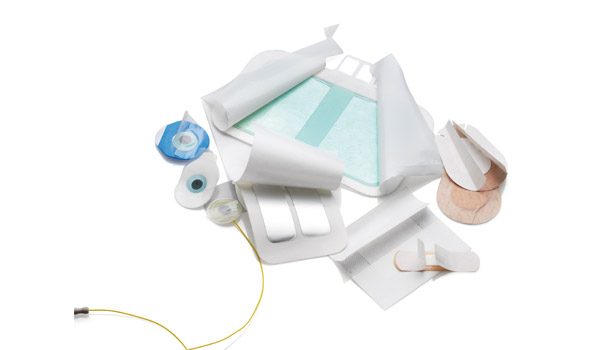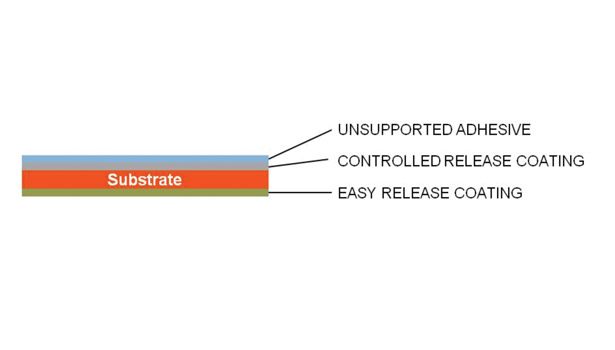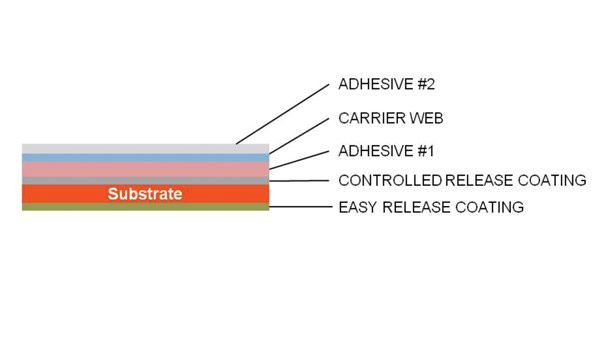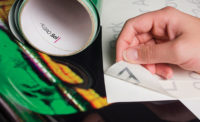Differential release liners play a critical role in the coated product supply chain and adhesives product development. They are vital to product performance and often serve as crucial components in the manufacture of tapes, fiber composite, and medical materials.
A differential release liner is a paper or filmic web coated on both sides with silicon-based release coatings that are designed to provide differing release values to the specific adhesives applied to them. Differential release liners provide a means to protect and transport a pressure-sensitive adhesive (PSA), fiber composite material or heat-sealable adhesive to its application point, where the liner can be removed to leave only the adhesive in place.
If a differential release liner does its job well, it becomes such a seamless part of the adhesive delivery system that the user might forget it’s even there. If liners do not perform to standards, the results are malfunctioning adhesives, frustrated customers, and major quality and production problems.
Why Differential Release?
Generally speaking, release liners are “the anti-adhesive.” While an adhesive’s purpose is to stick on everything, the release liner’s purpose is to prevent adhesives from sticking until the user is ready for application. High-quality release liners enable simple adhesive application for a satisfactory consumer experience, along with the efficient application of adhesives in production processes. In short, the liner ensures that the adhesive is delivered effortlessly.
Liners are available in two primary types: one-side coated (C1S) release; and two-side coated (C2S), or differential release. Both protect an adhesive until it is time for application at its end use and are specially formulated to have the correct surface energy to pull away while leaving the adhesive fully intact and functional. A well-rounded release liner supplier possesses the release chemistry and technology to accommodate virtually any adhesive formulation.
C1S release liners and C2S differential release liners have specific functional requirements, and there are key distinctions between these functions. C1S liners provide protection for an adhesive that is laminated to a film or paper substrate. In addition, because they provide a good, flat, uniform surface, they are used as a die-cutting base. These C1S liners primarily serve as a delivery mechanism for adhesives undergoing automatic or manual labeling and graphic arts applications.
In comparison, C2S differential release liners are typically used to carry an adhesive that must be wound together with the release liner upon itself and then unwound for use. In such a wound roll, both surfaces of the adhesive film are contacting the two surfaces of a release liner. For that reason, both surfaces of a release liner need to be silicone covered.
In another form, a differential release liner can carry two adhesives with a substrate in between that, again, can be wound onto and unwound from a roll. In other words, differential release is essential when working with transfer adhesives, or using two different adhesives on two sides of a substrate. In either situation, the liner must have two different release values (surface energies) for proper performance (see Figure 1). That release value is the force needed to remove an adhesive product from a release liner surface. This force is closely related to the surface energy.
For example, take the case of a two-sided PSA tape, which is one of the primary applications for differential release liners. The liners for these tapes typically have a coating with a tight release value on one side and a coating with an easy release value on the other side. This liner construction enables the adhesive tape to easily be rolled, unrolled and applied without the adhesive confusing or sticking to the wrong side of the differential release liner (see Figure 2).
Adhesive confusion occurs when the double-sided adhesive tape does not “recognize” from which side to release first. Instead, the tape jumps during the unwinding process from one release liner surface to the other. As a result, the tape is usually damaged and rendered essentially useless.
Manufacturing Overview
Because there are two chemistries (both usually silicone) at work on two sides of the liner, the differential release liner development process can be complex. It is important to look for a liner supplier with deep silicone chemistry expertise and the ability to handle a variety of materials and applications with consistent results.
Release coatings on each side must provide a precise release response to the adhesives with which they will come in contact. If the release chemistries do not function properly with the adhesives they contact, there will be adhesive confusion. Adhesive confusion can cause adhesive tapes to not release easily, to unwind improperly, or to pull off prematurely or partially, to name just a few potential quality problems.
Suppliers of differential release liners must have a strong understanding of the overall adhesive product end-use requirements to ensure optimal function of a product’s entire adhesive system. They work very closely with their customers’ product engineers to understand the end product’s performance requirements. They also collaborate with process engineers to understand each customer’s unique manufacturing requirements, equipment and constraints.
In addition, differential release liner suppliers cooperate with entities throughout the supply chain, including film and paper manufacturers, to ensure that substrates will work optimally with specific liner coatings and adhesive formulations. The actual carrier selected for a liner is dictated by the product end use and cost considerations.
To produce the differential release liner, the supplier runs a carrier material through a high-speed coating machine, which applies a coating with one release value on one side and a different coating with another release value on the other side. The silicone coating is cured using one of several types of energy sources, most often thermal curing or UV irradiation. Specific silicone chemistries, including emulsion, solvent and solventless systems, are utilized to align precisely with the release requirements of the adhesive(s). Coating techniques commonly employed in the manufacture of release liners are Meyer rod, direct gravure, offset gravure and multi-roll coaters (for the production of five and six rolls).
Liners are shipped to producers of adhesive goods, as well as fiber composite manufacturers and heat-seal adhesive manufacturers. These companies then apply their adhesives to the proper side of the C2S liner, and the adhesive is ready for safe transport to its end-use application.
Common Applications
Uses for differential release liners span myriad industries. In the graphics and signage market, for example, they are used for two-way window decals and piggyback labeling on magazines and coupons. In construction, they are used for roofing tapes and other applications. In electronics, the liners are carriers for very thin adhesives that hold together mobile phones, flat panel displays and similar devices. As previously mentioned, three other key markets include PSA tapes, carbon fiber composites and medical applications.
PSA Tapes
The largest market for differential release liners, PSA tapes are produced for many end-use applications. Examples of just a few are two-sided industrial tapes and poster-mounting tape, window insulation kits, and medical tapes. This family of adhesive applications encompasses two primary camps: unsupported adhesives and supported adhesives. Both rely on differential release liners for full function and ease of use.
Unsupported adhesives, or transfer adhesives, are those in which the tape consists of only the differential release liner and an adhesive coating on one side of the liner. Because the liner has different release values on its two sides, the tape can be rolled onto and unrolled from itself without adhesive confusion.
In the case of supported adhesives, the adhesive manufacturer leverages two different adhesive systems. A support web material is added between the two adhesives, and this layered system is applied to the control, or tight release, side of the differential release liner (see Figure 3).
As with unsupported adhesives, supported adhesives also may be rolled and unrolled smoothly. The adhesives recognize the easy release liner and respond by releasing easily from that side of the liner. Meanwhile, the adhesive remains tightly adhered to the tight release, or controlled release, side of the liner. Both sides maintain optimal stickiness for application. This functionality is essential when an application requires differing levels of stickiness, or two different adhesive formulations, to adhere to two different substrates, such as plastic and metal or carpet and flooring.
Carbon Fiber Composites
Increasingly used in the aerospace industry, components made of carbon fiber composite materials are extremely strong, yet also lightweight. In the production process, differential release liners act as a carrier web, or casting sheet, for the composite’s viscous epoxy mixture before the resin solution is impregnated with carbon fibers, cured and hardened. Differential release liners also are used as a processing material in the production of fiber composite products such as consumer recreational equipment, ballistic protection equipment, windmill blades, automotive components and other industrial applications.
Medical Applications
Beyond their prevalent use in medical bandages, which generally are classified as tape applications, differential release liners have many other medical uses. Transdermal patches are one example. Differential release liners are used to transport different adhesives to the patch manufacturing site, where the adhesive on one side of the liner is attached to the patch substrate, and then usually die cut as part of the patch production process. When it is time to administer the patch to the patient, the liner is then removed to expose a medical-grade adhesive, which adheres to the patient’s skin.
Developments and Trends
Leading suppliers of differential release liners continue to innovate toward the goal of improving their customers’ product performance, reducing costs and serving the many newly developing applications. In particular, they are integrating the latest polymers from silicone manufacturers. Each new generation of polymers brings new performance characteristics, such as lower processing temperatures. Because extremely high heat levels traditionally have been required to cure silicone, these new polymers hold the potential for reductions in energy usage and increases in processing speed.
On another front, the differential release liner market is evolving with the rapid advances of the aerospace industry. For example, as airlines work to make lighter planes with new composite formulations, liner suppliers must keep pace by demonstrating supply chain consistency and developing liners compatible with these new chemistries.
Differential release liner producers also are making progress in terms of environmental issues. The industry has moved almost entirely away from the use of solvents in its silicone emulsion technologies. Moreover, participants throughout the liner supply chain are increasing efforts to integrate polyester differential release liners into PET recycling programs, such as those used for plastic bottles and other plastic products. Work also continues toward developing an economically viable model for recycling polyethylene-coated liners into fuel pellets.
In other developments, liner producers continue to see a decline in fiber liner carriers and an uptick in filmic carriers, driven by demand for more consistent quality control and less bulk in end products. This surface quality traditionally has been achieved through a series of paper processing steps. Release liner manufacturers could extrude polyethylene onto paper to achieve a very smooth surface as well. The extrusion coating process provides an optimal surface for silicone coating, conserving relatively expensive silicone resources. As the market demands more consistent quality and lower caliper substrates, the trend is to move from fiber-based liners to the use of film carriers.
Continual Improvement
Leaders in the differential release liner industry are always looking for ways to improve performance and reduce costs for producers of adhesives and adhesive products. When comparing liner suppliers, it’s important to seek those with broad expertise and willingness to work with any adhesive formulation and application, including a wide range of substrates and cure methodologies, coating techniques, and chemistries.
Supply chain consistency is critical, and a global footprint with a diverse product portfolio can be advantageous. Ultimately, a high-quality differential release liner, regardless of the application, will enable the end product or manufacturing process to function and perform with ease and consistency.
For additional information, email martin.mcdonough@mondigroup.com or visit www.mondigroup.com.
Editor’s note: Images courtesy of Mondi Americas.
